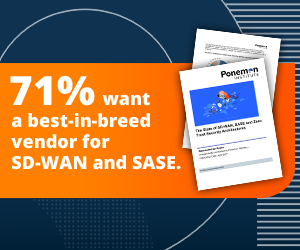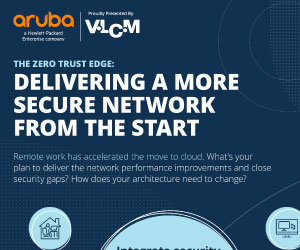What's your biggest worry?

There's plenty to keep you up at night.
And that was even before the pandemic. But with so many remote workers, IoT devices, and multiple clouds, it’s hard to balance keeping everyone productive while keeping the network secure.
Hybrid workplace or campus
According to Forrester, 53% of newly remote workers want to stay remote. So, the hybrid workplace is here to stay. But with remote work accelerating the move to cloud, how do you ensure the network’s security extends from edge-to-cloud?
More and more IoT devices
With more devices being connected to the network – some beyond IT’s control – how can you get away from manually generating VLANs that create confusion and introduce risk?
Vendor lock-in
With attacks getting more sophisticated, your security needs to be best-of-breed. How do you adopt cloud-based-security services as part of you overall Zero Trust/SASE framework without being locked into a single vendor?
Protect your network from edge-to-cloud with Zero Trust and SASE
Establish a Zero Trust and SASE Strategy
It’s important to use a network that has full visibility, control, and enforcement with a built-in foundation for Zero Trust and SASE (secure access secure edge) frameworks.
Move away from VLAN traffic segmentation
Zero Trust ensures that the same controls applied to campus or branch networks, also apply to the home or remote worker. That means no more manually generated VLANs that are confusing and risky. And real-time identity-based access control consistently protects the network from edge-to-cloud.
Integrate your Zero Trust/SASE framework with your security ecosystem
As more applications move to the cloud, organizations need to think about extending their current security architecture into the cloud without redoing what they currently have (and increasing risk). It’s best to pair network-enforced, identity-based access control and tight integration with leading cloud security providers like Zscaler, Netskope, Check Point, Palo Alto Networks, and others.

The state of SD-WAN, SASE and Zero Trust Security architectures
The Ponemon Institute surveyed 1,826 security and networking practitioners globally and found that 71% would select a best-in-breed vendor when deploying both SD-WAN and cloud-delivered security for a SASE architecture. Meaning, respondents do not want to be locked into a single vendor. Read the rest of their findings about the future of networking and security.
The hybrid workplace in 4 steps
Aruba ESP powers the hybrid workplace with built-in network intelligence and cloud-native capabilities to keep workers safe and productive.
Extend the network to the home
Here’s how it works. IT ships an AP to the employee’s home; the employee plugs it in, downloads a configuration from the cloud, and they’re all set. Centrally managed access credentials map to corporate policies to keep the network secure. And it’s all centralized managed from the cloud—IT gets full visibility and AIOps assisted troubleshooting from anywhere.Reinforce in-office social distancing
As employees return to the office, it’s important for facilities to be able to modify floorplans based on foot traffic or to change cleaning schedules based on density. With Aruba WLAN’s built-In network intelligence and location-aware capabilities, it’s easy to use density mapping to keep the workplace safe.Minimize risk with contact tracing
Aruba’s network-based approach uses both proximity and location telemetry to perform contact and location tracing, and the advanced AI capabilities ensure pinpoint accuracy so you’re able to see which people intersected and the exact location of the interaction.Consume As-a-Service
It’s now more important than ever to keep financial flexibility top of mind. Aruba's network-as-a-service options allow you to respond to rapidly changing business requirements, manage tight budgets, and easily deploy the latest networking technologies.See how Aruba security solutions can help
Know what’s on your network and then ensure that the same controls applied to campus or branch networks, also extend to the home or remote worker.
Network access control
- Agentless policy control and automated response
- Dynamically enforced access privileges
- Secure access for guests, IoT, AND BYOD
Device discovery and profiling
- Know what's on your network
- Identify and analyze role-based policies
- Apply and enforce role-based policies
Unified threat management
- Fully integrated attack prevention
- Least access and micro-segmentation
- Context-aware control

